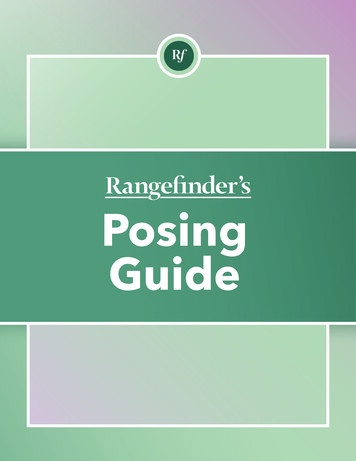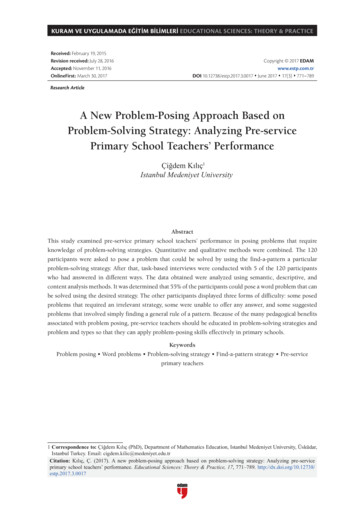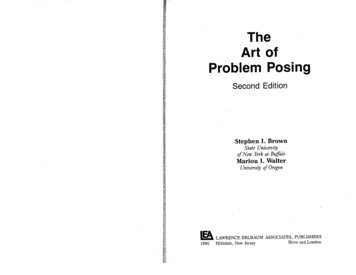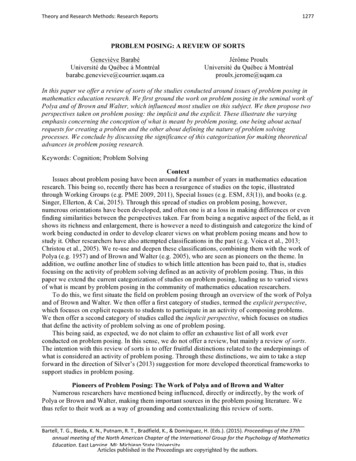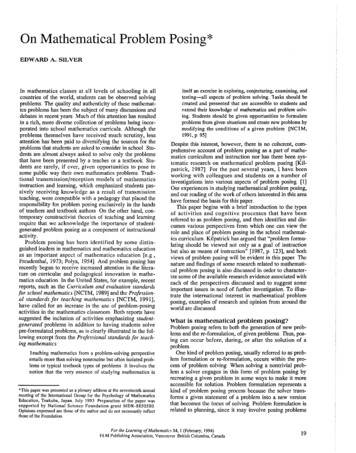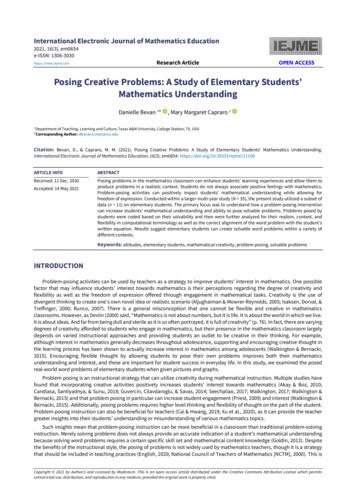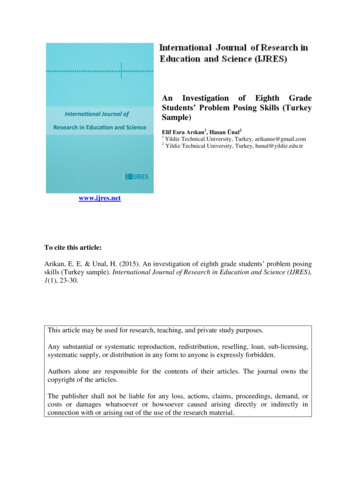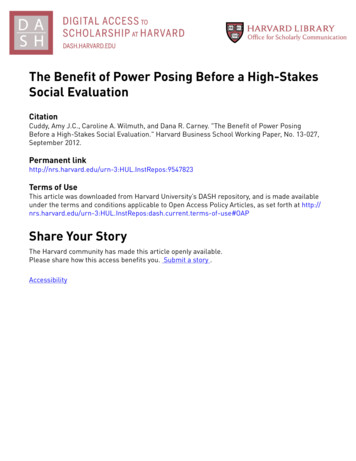
Transcription
The Benefit of Power Posing Before a High-StakesSocial EvaluationCitationCuddy, Amy J.C., Caroline A. Wilmuth, and Dana R. Carney. "The Benefit of Power PosingBefore a High-Stakes Social Evaluation." Harvard Business School Working Paper, No. 13-027,September 2012.Permanent 7823Terms of UseThis article was downloaded from Harvard University’s DASH repository, and is made availableunder the terms and conditions applicable to Open Access Policy Articles, as set forth at rrent.terms-of-use#OAPShare Your StoryThe Harvard community has made this article openly available.Please share how this access benefits you. Submit a story .Accessibility
The Benefit of Power PosingBefore a High-Stakes SocialEvaluationAmy J. C. CuddyCaroline A. WilmuthDana R. CarneyWorking Paper13-027August 31, 2012Copyright 2012 by Amy J. C. Cuddy, Caroline A. Wilmuth, and Dana R. CarneyWorking papers are in draft form. This working paper is distributed for purposes of comment anddiscussion only. It may not be reproduced without permission of the copyright holder. Copies of workingpapers are available from the author.
Preparatory Power Posing and Social Evaluation 1RUNNING HEAD: Preparatory Power Posing Affects PerformanceThe Benefit of Power Posing Before a High-Stakes Social EvaluationAmy J. C. Cuddy & Caroline A. Wilmuth, Harvard UniversityDana R. Carney, University of California at BerkeleyCorresponding Author: Amy Cuddy, acuddy@hbs.eduKey Words: Power, Power Posing, Social Evaluation, Nonverbal Behavior
Preparatory Power Posing and Social Evaluation 2AbstractThe current experiment tested whether changing one‘s nonverbal behavior prior to a high-stakessocial evaluation could improve performance in the evaluated task. Participants adoptedexpansive, open (high-power) poses, or contractive, closed (low-power) poses, and then preparedand delivered a speech to two evaluators as part of a mock job interview, a prototypical socialevaluation. All speeches were videotaped and coded for overall performance and hireability, andthe potential mediators of speech quality (e.g., content, structure) and presentation quality (e.g.,captivating, confident). As predicted, high power posers performed better and were more likelyto be chosen for hire, and this relationship was mediated only by presentation quality, not speechquality. Power pose condition had no effect on body posture during the social evaluation, thushighlighting the relationship between preparatory nonverbal behavior and subsequentperformance.Word count as is: 133Word count limit: 150
Preparatory Power Posing and Social Evaluation 3Although virtually every social interaction involves reciprocal evaluations, the stakes areoften higher in one direction than the other. That is, one party often has more power to impactthe future of the other, controlling access to coveted resources such as college admissions, jobs,and venture capital. For example, in a job interview, the interviewer has power over the jobcandidate‘s future, and consequently the importance of the interviewer‘s evaluations of thecandidate dwarf the importance of the candidate‘s evaluations of the interviewer. However, inthe moments before walking into high-stakes social evaluation many people shrink in their chairsand hunch over their phones, adopting nonverbal postures that can cause them to feel even morepowerless (Carney, Cuddy, & Yap, 2010). But what if people did the opposite – stretching outand occupying more space, rather than slouching and taking up less?In both human and non-human primates, expansive, open postures reflect high power,whereas contractive, closed postures reflect low power (Carney, Hall, & Smith LeBeau, 2005;Darwin, 1872/2009; de Waal, 1998; Hall, Coats, & Smith LeBeau, 2005). Not only do thesepostures reflect power, they also produce it; in contrast to adopting low power poses, adoptinghigh power poses increases explicit and implicit feelings of power and dominance, risk-takingbehavior, action orientation, pain tolerance, and testosterone (the dominance hormone), whilereducing stress, anxiety, and cortisol (the stress hormone; Bohns & Wiltermuth, 2011; Carney,Cuddy, & Yap, 2010; Carney, Yap, Lucas, Mehta, Ferrero, McGee, & Wilmuth, under review;Huang, Galinsky, Gruenfeld, & Guillory, 2011). Moreover, compared to classic powermanipulations that do not involve nonverbal behavior, such as role assignments and power recallprimes, adopting high-power poses leads to stronger effects on thought abstraction and actionorientation (Huang et al., 2011).
Preparatory Power Posing and Social Evaluation 4The acquisition of power causes individuals to feel more positive, in control, andoptimistic about the future, and to become more goal-oriented and likely to take action(Anderson & Galinsky, 2006; Burgmer & Englich, 2012; Anderson & Berdahl, 2002; Galinskyet al., 2008; Guinote, 2007; Smith, Jostmann, Galinsky, & van Dijk, 2008). Thus, power couldimprove performance in high-stakes social evaluations by positively orienting people towardgoals and by liberating them from the psychological constraints that could prevent them fromperforming to their full potential. Given that it is often difficult or risky to overtly change thepower dynamics in such a situation, assuming a high-power pose represents a subtle way ofmaking oneself feel more powerful.The aim of the current research was to test whether adopting high- vs. low-power posesbefore a high-stakes social evaluation can improve an individual‘s performance on the evaluatedtask. We also sought to identify the mechanism through which power posing could improveperformance by considering two possible mediators: speech quality and presentation quality.Speech quality – the extent to which the content of the speech is intelligent, clear, and wellstructured – influences potential investors‘ evaluations of and level of interest in pursuingentrepreneurs‘ proposed investment opportunities, for example (Clark, 2008). Presentationquality – the extent to which the presentation of the speech is enthusiastic, confident, andcaptivating – significantly predicts interviewers‘ general evaluations of applicants and finalhiring decisions (Young & Kacmar, 1998). Similarly, an examination of 185 videotaped twominute VC pitches revealed that venture capitalists were far more likely to invest inentrepreneurs who displayed confidence, passion, and enthusiasm (Balachandra, under review).The enhanced cognitive functioning resulting from power (Smith et al., 2008) suggests that highpower poses may boost speech quality; however, considerably more research implies that high
Preparatory Power Posing and Social Evaluation 5power poses would impact presentation quality. Power reduces stress, anxiety, and negativeaffect, which would presumably make an individual more confident, captivating, and enthusiastic(Carney et al., under review; Anderson & Berdahl, 2002). Furthermore, high testosterone andlow cortisol, a hormone profile that is characteristic of high-status and effective leaders and isinduced by power posing, is associated with reduced stress, increased sense of personal control,and increased engagement and performance in competitive tasks – all of which underliepresentation quality (Carney, Cuddy, & Yap, 2010; Sherman, Lee, Cuddy, Renshon, Oveis,Gross, & Lerner, in press; Mehta, Jones, & Josephs, 2008; Mehta & Josephs, 2010).Preparatory power posing might serve as a simple, free tool that has the potential to beadopted by and beneficial to almost anyone. Thus, the current experiment tested the hypothesesthat (1) power posing before a high-stakes social evaluation improves performance in theevaluated task, and (2) this effect is mediated by presentation quality, not speech quality.MethodsParticipants and Procedure.Sixty-six Columbia University students participated in a study called ―Physical Motionand Performance,‖ and were paid 15 for their participation. Five participants were excludedfrom analyses: four did not understand the instructions for the speech task and one did notmaintain the power poses during speech preparation, reducing the total N to 61 (40 women and21 men; 22 white, 12 black, 20 Asian, 5 Latino, 2 ―other). Participants were randomly assignedto adopt either two (one standing, then one sitting) high-power (i.e., expansive and open) or twolow-power (i.e., contractive and closed) postures for one minute each. While in the poses,participants engaged in an impression formation task, wherein they watched a slideshow ofpictures on the computer and were asked to form opinions about the people in the pictures.
Preparatory Power Posing and Social Evaluation 6After completing the power manipulation, participants engaged in an adaptation of theTrier Social Stress Test (Kirschbaum, Pirke, & Hellhammer, 1993). They were asked to imaginethat they are about to interview for their dream job and then to prepare and perform a five-minutespeech detailing their strengths, qualifications, and why they should be chosen for the job to two―experienced evaluators‖. To reinforce the power manipulation, participants were instructed tomaintain the second high- or low-power pose during the five-minute preparation phase, bringingthe total time participants spent in the poses to 7 minutes. Speech preparation and performancewere videotaped to verify that the poses were maintained in the preparation phase and to code forthe performance measures in the performance phase. Immediately after giving their speeches,participants completed a three-item measure of self-reported feelings of power, answering howdominant, in control, and powerful they felt on a 5-point scale (1 not at all, 5 a lot), α .82.Variable Coding & Inter-Rater Reliability.Four trained, hypothesis- and condition-blind coders coded the videotaped speeches ontwo dependent and two mediator variables. The two main dependent variables were (1) overallperformance (―Overall, how good was the interview?‖ 1 awful, 7 amazing), and (2)hireability (―Should this participant get the job?‖ 1 no, 2 maybe, 3 yes). The two potentialmediating variables were coded using 7-point Likert-style scales (1 not at all, 7 extremely);each was a composite of multiple individually-coded variables: (1) speech quality (qualifications,intelligent, structured, straightforward; α .89), and (2) presentation quality (captivating,confident, enthusiastic, awkward (reverse scored); α .79). As is typically done, two codersrated the same subset of 10% of the videos, and inter-rater reliability was calculated on thatsubset for each variable (Carney et al., 2005). After inter-rater reliability was determined to besubstantially high (i.e., α .70), one of the coders went on to rate the remaining 90% of the
Preparatory Power Posing and Social Evaluation 7videos. The average inter-rater reliability for all of the variables was .90, with a range of .80 to.98. Table 1 presents inter-rater reliabilities for all variables.ResultsManipulation Check.As expected, high-power posers felt significantly more powerful (M 2.56) than lowerpower posers (M 2.07), F(1) 4.021, p .05, ηp2 .065.Overall Performance and HireabilityOne-way analyses of variance (ANOVA) examined the effect of power poses onperformance and hireability. As hypothesized, coders rated high-power posers significantlyhigher on performance (M 4.63) than low-power posers (M 3.81), F(1) 8.33, p .005, partialηp2 .124; and rated high-power posers significantly higher on hireability (M 2.43) than lowpower posers (M 2.00), F(1) 7.22, p .009, ηp2 .109.MediationTo better understand why high-power posers experienced better job interview outcomeson the critical DVs, performance and hireability, both possible mediators were regressed onto thedependent variables. Presentation quality predicted both performance (β .772, t(60) 6.24 p .000) and hireability (β .405, t(60) 2.238, p .029). Speech quality predicted neitherperformance (β .049, t(60) .398 p .692) nor hireability (β .139, t(60) .766 p .447).Our next set of analyses tested mediation. Two separate series of analyses – one forperformance and one for hireability -- regressed (a) performance/hireability (the criterion) ontopower pose (the predictor); (b) presentation quality (the mediator) onto power pose; and (c)simultaneously performance/hireability onto both power pose and presentation quality. Figures 1and 2 present the results of those analyses. As predicted, presentation quality fully mediated the
Preparatory Power Posing and Social Evaluation 8effects of power pose on both overall performance (Sobel Z 2.21, p .027) and hireability(Sobel Z 2.03, p .042).Body Expansiveness DURING the SpeechTo rule out the possibility that body expansiveness during the interview was inflatingperformance ratings, by signaling high vs. low power, we also coded the videos for bodyexpansiveness during the speeches on a 7-point scale (1 very contractive, 7 very expansive). Aone-way ANOVA revealed no significant difference between high- (M 0.48) and low-powerposers (M 0.47) on body expansiveness during the interview F(1,59) .001, p .97, partial ηp2 .000.DiscussionThe current experiment demonstrated that preparatory power posing affects participants‘presentation quality during a job interview, which influences judges‘ evaluations and hiringdecisions. The high-power posers, in contrast to low-power posers, appeared to better maintaintheir composure, project more confidence, and present more captivating and enthusiasticspeeches, in turn leading to higher overall performance evaluations. Power posing did not affectspeech quality.Previous research has focused on how nonverbals that are enacted during interactions affecthow a perceiver evaluates and responds to the actor. For example, smiling, hand gesturing,nodding, and leaning forward during an interview increase a person‘s chance of being selected(Gifford, Ng, & Wilkinson, 1985; Parsons & Liden, 1984; Word, Zanna, & Cooper, 1973). Theexperiment presented here goes a step further, demonstrating how nonverbal behavior that isenacted before an interaction can also influence how a perceiver evaluates and responds to theactor, even when the perceiver has not observed the actual nonverbal display. As reported, high-
Preparatory Power Posing and Social Evaluation 9and low-power posers did not differ in the extent to which they adopted expansive vs. contractivepostures during the interview; it was preparatory power posing that impacted perceivers‘evaluations of and responses to the actor.It is possible that power posing boosted participants‘ performance during the preparationphase, which then improved performance during the actual interview. As previous research hasshown, psychological power enhances executive function (Smith et al., 2008), which is critical tothe ability to effectively plan and prepare for challenging situations. If power posing causedparticipants to better prepare, it may have improved interview performance via one or both of thefollowing routes: by improving the quality of the speech itself, or by boosting confidence as aresult feeling more prepared. The results of this study do not support the former given thatspeech quality was not affected by power pose condition. Future research could explore whetherand how power posing impacts preparation for social evaluations.High-stakes social evaluations are characterized by a power asymmetry in the sense that theevaluator has control over the future of the individual being evaluated. By nonverballymanipulating power, the high-power posers were effectively imbued with the psychological andphysiological perks typically associated with high power, despite being low-power in relation tothe evaluators. This suggests that preparatory power posing can serve as a simple, free,nonverbal tool that has the potential to be adopted by and beneficial to almost anyone, includingthose who are chronically powerless due to lack of physical resources or hierarchical status.
Preparatory Power Posing and Social Evaluation 10Table 1. Variable Descriptions and Inter-Rater ReliabilitiesVariableDescription / Coder InstructionsExpansivenessHow expansive was the speaker‘s body?Inter-raterreliability (r).96Performance:How good was the interview?Overall performanceHireability.97Should this person get the job?.80EnthusiasticHow enthusiastic was the speaker?.88CaptivatingExtent to which the speaker captured your attention.81ConfidentExtent to which the speaker seemed confident.95Awkwardness (reversescored)Extent to which the speaker seemed awkward.92StructuredHow structured and organized was the speech?.89StraightforwardHow straightforward was the speech?.93IntelligentHow smart and intelligent did the speaker comeacross?.94QualificationsHow impressive were the qualifications that thespeaker mentioned in the speech?.87Presentation Quality:Speech Quality:
Preparatory Power Posing and Social Evaluation 11Figure 1.283, p .03PowerPosePresentationQuality.811, p .000OverallPerformance.133, p .095(.352, p .005)
Preparatory Power Posing and Social Evaluation 12Figure 2.283, p .03PowerPosePresentationQuality.513, p .000Hireability.201, p .084(.330, p .009)
Preparatory Power Posing and Social Evaluation 13Figure CaptionsFigure 1. Regression analyses showing that presentation quality mediated the effect of powerpose on overall job interview performance. The coefficient in parentheses represents the directeffect of power pose on performance, whereas the adjacent coefficient was observed whenpresentation quality was added to the model. Broken lines indicate nonsignificant effects. Sobeltest: Z 2.21, p .027.Figure 2. Regression analyses showing that presentation quality mediated the effect of powerpose on ratings of whether or not the person should be hired. The coefficient in parenthesesrepresents the direct effect of power pose on hireability, whereas the adjacent coefficient wasobserved when presentation quality was added to the model. Broken lines indicate nonsignificanteffects. Sobel test: Z 2.03, p .042.
Preparatory Power Posing and Social Evaluation 14AcknowledgmentsThe authors enthusiastically thank Madeline Bernstein, Christina Leonelli, Emily Rutter, andVera Sundström for their contributions to this research, and Pam Smith for her very helpfulfeedback on a draft of this paper
Preparatory Power Posing and Social Evaluation 15ReferencesAnderson, C., & Berdahl, J. L. (2002). The experience of power: Examining the effects of poweron approach and inhibition tendencies. Journal of Personality and SocialPsychology, 83, 1362–1377.Anderson, C., Galinsky, A. D. (2006). Power, optimism, and risk taking. European Journal ofSocial Psychology, 36, 511-536.Balachandra, L and Briggs, T. (under review). Pitch Perfect: The Role of Entrepreneur AffectSignaling in Early Stage Investment Decisions.Bohns, V., & Wiltermuth, S. (2012). It hurts when I do this (or you do that): Posture and paintolerance. Journal of Experimental Social Psychology, 48, 341-345.Burgmer, P., & Englich, B. (2012). Bullseye! How power improves motor performance. SocialPsychological and Personality Science, 3, 1-9.Carney, D. R., Cuddy, A. J. C., Yap, A. J. (2010). Power posing brief nonverbal displays affectneuroendocrine levels and risk tolerance. Psychological Science, 21, 1363-1368.Carney, D. R., Hall, J., Smith LeBeau, L. (2005). Beliefs about the nonverbal expression ofsocial power. Journal of Nonverbal Behavior, 29, 105-123.Carney, D. R., Yap, A. J., Lucas, B., Mehta, P., Ferrero, J. N., McGee, J. A., & Wilmuth, C. A.(under review). Does power corrupt? Or does power buffer stress—for better or worse?Administrative Science Quarterly, Special Issue on Power.Clark, C. (2008). The impact of entrepreneurs‘ oral ‗pitch‘ presentation skills on business angels‘initial screening investment decisions. Venture Capital, 10, 257-279.Darwin, C. (2009). The expression of the emotions in man and animals. New York, NY: Oxford.(Original work published 1872)de Waal, F. (1998). Chimpanzee politics: Power and sex among apes. Baltimore, MD: JohnsHopkins University Press.Galinsky, A. D., Magee, J. C., Gruenfeld, D. H., Whitson, J. A., & Liljenquist, K. A. (2008).Power reduces the press of the situation: Implications for creativity, conformity, anddissonance. Journal of Personality and Social Psychology, 95, 1450-1066.Gifford, R., Ng, C., & Wilkinson, M. (1985). Nonverbal cues in the employment interview:Links between applicant qualities and interviewer judgments. Journal of AppliedPsychology, 70, 729-736.Guinote, A. (2007). Power and goal pursuit. Personality and Social Psychology Bulletin, 33,1076-1087.Hall, J. A., Coats, E. J., & Smith LeBeau, L. (2005). Nonverbal behavior and the verticaldimension of social relations: A meta-analysis. Psychological Bulletin, 131, 898–924.Huang, L., Galinsky, A. D., Gruenfeld, D. H., Guillory, L. (2011). Powerful postures versuspowerful roles: Which is the proximate correlate of thought and behavior? PsychologicalScience, 22, 95-102.Keltner, D., Gruenfeld, D. H., Anderson, C. (2003). Power, approach and inhibition.Psychological Review, 110, 265-284.Kirschbaum, C., Pirke, K. M., & Hellhammer, D. H. (1993). The ‗Trier Social Stress Test‘ – atool for investigating psychobiology stress responses in a laboratory setting.Neuropsychobiology, 28, 76-81.Mehta, P. H., & Josephs, R. A. (2010). Testosterone and cortisol jointly regulate dominance:Evidence for a dual-hormone hypothesis. Hormones and Behavior, 58, 898-906.
Preparatory Power Posing and Social Evaluation 16Mehta, P.H., Jones, A.C., & Josephs, R.A. (2008). The social endocrinology of dominance:Basal testosterone predicts cortisol changes and behavior following victory and defeat.Journal of Personality and Social Psychology, 94, 1078-1093.Parsons, C. K., & Liden, R. C. (1984). Interviewer perceptions of applicant qualifications: Amultivariate field study of demographic characteristics and nonverbal cues. Journal ofApplied Psychology, 69, 557-568.Sherman, G. D., Lee, J. J., Cuddy, A. J. C., Renshon, J., Oveis, C., Gross, J. J., & Lerner, J. S. (inpress). Leadership is associated with lower levels of the stress hormone cortisol.Proceedings of the National Academy of Sciences.Smith, P. K., Jostmann, N. B., Galinsky, A. D., & van Dijk, W. W. (2008). Lacking powerimpairs executive functions. Psychological Science, 19, 441-447.Word, C. O., Zanna, M. P., & Cooper, J. (1973). The nonverbal mediation of self-fulfillingprophecies in interracial interaction. Journal of Experimental Social Psychology, 10, 109120.Young, A., Kacmar, M., (1998). ABCs of the interview: The role of affective, behavioral, andcognitive responses by applicants in the employment interview. International Journal ofSelection and Assessment, 6, 211-221.
Preparatory Power Posing and Social Evaluation 17Supplementary Online MaterialsPower Posing Instructions:High-power Condition―This study is about physical motion and performance and so there is a physical positionwe‘d like you to try out. Please stand up and stand with your two feet apart and hands on yourhips like this [experimenter demonstrates for participant]. You will maintain this pose for oneminute and then after one minute is up, I notify you to get into a second pose. The second poseinvolves you sitting in the chair with your hands behind your head and your feet up on the tablelike this [experimenter demonstrates for participant]. While you are maintaining these positions,you will be viewing pictures on the computer screen. Please form an opinion or impression ofthe people in the pictures.‖Low-power Condition―This study is about physical motion and performance and so there is a physical positionwe‘d like you to try out. Please stand up and stand with your two feet crossed over one anotherand your hands crossed over your hips like this [experimenter demonstrates for participant]. Youwill maintain this pose for one minute and then after one minute is up, I notify you to get into asecond pose. The second pose involves you sitting in the chair with your hands crossed overyour knees and your feet crossed at the ankles [experimenter demonstrates for participant].While you are maintaining these positions, you will be viewing pictures on the computer screen.Please form an opinion or impression of the people in the pictures.‖Trier Social Stress Test Instructions:―Now what we are going to do is to have you prepare a speech. Imagine that you areabout to interview for your dream job. We‘d like you to stay in this position and think aboutwhat you will say. You will have 5 minutes to prepare then you will deliver your speech for 5minutes to 2 evaluators. The other experimenter and I will evaluate your performance on thespeech task. We will be evaluating your nonverbal behavior and what you say and how you sayit. Remember, (It was written in the incorrect way because Dana thought it was more impactfuleven though it was grammatically incorrect. Should we just put it as the correct way as youcorrected because otherwise people who read it will think we don‘t know the correct phrasing?)you really want this job. You should be honest and straightforward and talk about yourexperiences, strengths, and why YOU should be chosen for this job. You should keep thisphysical position while you are preparing the speech. To prepare just think through what youwant to say and you may practice. I am going to turn on this video camera while you prepare.The camera is so that we can later verify that you maintained this physical position. Remember,you are preparing for 5 minutes then you will deliver a five-minute speech to two evaluators. Doyou have any questions? I am turning on the video camera now and I will leave the room whileyou prepare. I will be back in 5 minutes.‖Additional Instructions Given After Speech Preparation Phase―You can now stand however you like. I am X and this is Y. We are both experiencedevaluators. We will be evaluating how you perform on your speech on a number of different
Preparatory Power Posing and Social Evaluation 18dimensions. We will be observing your nonverbal behavior, listening to what you say, and howyou say it. We will be taking some notes while you are giving your five-minute speech. Thecamera is rolling and you may begin whenever you are ready. Please begin by stating what yourideal job is.‖
Corresponding Author: Amy Cuddy, acuddy@hbs.edu Key Words: Power, Power Posing, Social Evaluation, Nonverbal Behavior . Preparatory Power Posing and Social Evaluation 2 Abstract The current experiment tested whether changing one's nonverbal behavior prior to a high-stakes


